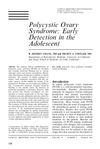Some Clues and Pitfalls in the Diagnosis of Acromegaly
July 2004
in “
Endocrine practice
”
TLDR Acromegaly can be hard to diagnose in young women with atypical symptoms, and persistent high phosphate levels should lead to growth hormone testing.
The document describes the case of a 31-year-old woman who was initially evaluated for amenorrhea after stopping oral contraceptives and was misdiagnosed with conditions like "postpill amenorrhea" and polycystic ovary syndrome due to nonspecific symptoms such as weight gain, acne, and increased facial hair. However, persistent hyperphosphatemia and further endocrinological evaluation revealed increased levels of insulin-like growth factor-I and growth hormone (GH), leading to the diagnosis of acromegaly. A pituitary macroadenoma was discovered and subsequently removed via transsphenoidal resection. The case emphasizes that acromegaly can be difficult to diagnose in young women, especially when symptoms are atypical and masked by factors like oral contraceptive use. The study suggests that persistent hyperphosphatemia should prompt screening for GH excess to facilitate early diagnosis and treatment of acromegaly.




